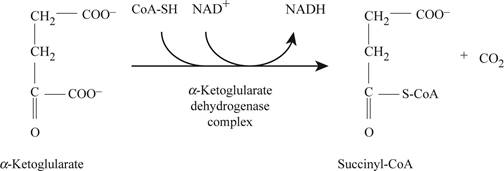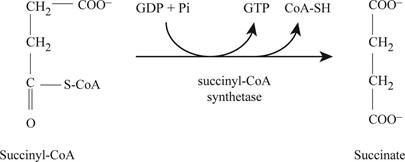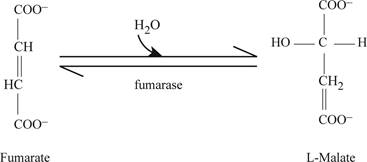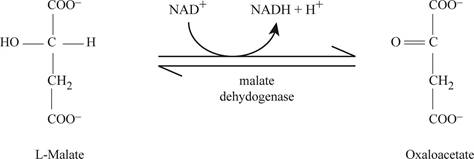
Concept explainers
(a)
To write: A balanced equation of the reactions catalyzed by each enzyme of citric acid cycle.
Concept introduction: Citric acid cycle is also known as the TCA cycle (Tricarboxylic acid cycle) or Krebs’s cycle. Pyruvate obtained from glycolysis is first converted into acetyl groups, these groups enter into citric acid cycle. In citric acid cycle the sugars, amino acids, and fatty acids are oxidized into CO2 and H2O.
(a)
Explanation of Solution
Explanation:
Enzymes used in TCA are citrate synthase, aconitase, isocitrate dehydrogenase, α- ketoglutarate dehydrogenase, succinyl CoA synthetase, succinate dehydrogenase, fumarase, and malate dehydrogenase.
Before citric acid cycle starts, pyruvates give acetyl-CoA which enters the citric acid cycle. Acetyl CoA reacts with oxaloacetate to produce citrate with the help of citrate synthase as shown in Fig.1.
Aconitase is responsible for conversion of citrate into isocitrate as shown in Fig.2.
Isocitrate dehydrogenase converts isocitrate into α- ketoglutarate as shown in Fig.3.
α- ketoglutarate dehydrogenase complex converts α- ketoglutarate into succinyl- CoA as shown in Fig.4.
Succinyl co A is converted into succinate, the succinyl CoA synthetase catalyses the reaction. Succinate is an intermediate and quickly gets converted into fumarate with the action of succinate dehydrogenase as shown in Fig.5.
In the next step of reaction hydrolysis of fumarate takes place and it gets convert into malate as shown in Fig.6.
Malate dehydrogenase catalyzes malate to get it convert into oxaloacetate as shown in Fig.7.
Pictorial representation: The reactions catalyzed by the enzymes in citric acid cycle is represented in the following figures.

Fig1: Enzyme citrate synthase activity.

Fig2: Enzyme aconitase activity.

Fig3: Enzyme isocitrate dehydrogenase activity.

Fig4: Enzyme α- ketoglutarate dehydrogenase complex activity.

Fig5: Enzyme succinyl CoA synthetase activity.

Fig6: Enzyme fumarase activity.

Fig7: Enzyme malate dehydrogenase activity.
(b)
To name: The cofactors which are required for each enzymatic reactions.
Concept introduction:
Citric acid cycle is also known as the TCA cycle (Tricarboxylic acid cycle) or Krebs’s cycle. Pyruvate obtained from glycolysis is first converted into acetyl groups, these groups enter into citric acid cycle. In citric acid cycle the sugars, amino acids, and fatty acids are oxidized into CO2 and H2O.
(b)
Explanation of Solution
Explanation:
Presence of cofactors in the reactions is mandatory for the functioning of enzymes. Enzymes can catalyze the reaction only in the presence of cofactors.
When isocitrate converts into α- ketoglutarate then isocitrate dehydrogenase enzyme gets involve. The cofactor which is required at this step is NADH.
In the next step when α- ketoglutarate gets convert into succinyl CoA α- ketoglutarate dehydrogenase complex enzyme takes part and NADH is found present to facilitate the enzyme functioning.
GTP is the required cofactor when succinyl CoA synthetase catalyzes the conversion of succinyl CoA into succinate.
Fumarase enzyme uses FADH2 as its cofactor when fumarate is converted into malate.
NADH is present for the functioning of malate dehydrogenase when malate gets convert into oxaloacetate.
(c)
To determine: The types of reactions catalyzed, condensation, dehydration, hydration, decarboxylation, oxidation-reduction, substrate level phosphorylation and isomerization.
Concept introduction:
Citric acid cycle is also known as the TCA cycle (Tricarboxylic acid cycle) or Krebs’s cycle. Pyruvate obtained from glycolysis is first converted into acetyl groups, these groups enter into citric acid cycle. In citric acid cycle the sugars, amino acids, and fatty acids are oxidized into CO2 and H2O.
(c)
Explanation of Solution
Explanation:
Fig1 is showing the formation of citrate from acetyl coA, this process is Claisen condensation process because methyl group found on acetyl coA gets converted into methylene of citrate.
The conversion of citrate to isocitrate is isomerization reaction. Fig2 is showing the processof conversion of citrate into isocitrate with the formation of one intermediate cis- aconitate, in this process first dehydration and then rehydration takes place. Citrate undergoes dehydration and cis aconitate is obtained, then rehydration of cis aconitate takes place which produces isocitrate.
Fig 3 is showing the production of α- ketoglutarate from isocitrate via oxidative decarboxylation, hydroxyl group of isocitrate is oxidized into carbonyl.
Fig 4 is the reaction of conversion of α- ketoglutarate into succinyl coA which is a oxidative decarboxylation process.
Fig 5 is the step of conversion of succinyl coA into succinate via substrate level phosphorylation process.
The succinate is converted into fumarate via oxidation reaction. Fumarate is converted into L-Malate by hydration reaction. Finally by oxidation reaction L-Malate is converted into oxaloacetate.
Fig 7 is the dehydrogenation of malate to get convert into oxaloacetate.
(d)
To write: Net balanced equation of the catabolic reaction of acetyl CoA to CO2.
Concept introduction:
Citric acid cycle is also known as the TCA cycle (Tricarboxylic acid cycle) or Krebs’s cycle. Pyruvate obtained from glycolysis is first converted into acetyl groups, these groups enter into citric acid cycle. In citric acid cycle the sugars, amino acids, and fatty acids are oxidized into CO2 and H2O.
(d)
Explanation of Solution
Explanation:
Acetyl CoA is converted into CO2 along with amount of energy. Net equation of reaction of acetyl CoA to CO2 is:
Want to see more full solutions like this?
Chapter 16 Solutions
SAPLINGPLUS FOR PRINCIPLES OF BIOCHEMIS
- The following data were recorded for the enzyme catalyzed conversion of S -> P. Question: Estimate the Vmax and Km. What would be the rate at 2.5 and 5.0 x 10-5 M [S] ?arrow_forwardPlease helparrow_forwardThe following data were recorded for the enzyme catalyzed conversion of S -> P Question: what would the rate be at 5.0 x 10-5 M [S] and the enzyme concentration was doubled? Also, the rate given in the table is from product accumulation after 10 minuets of reaction time. Verify these rates represent a true initial rate (less than 5% turnover). Please helparrow_forward
- The following data was obtained on isocitrate lyase from an algal species. Identify the reaction catalyzed by this enzyme, deduce the KM and Vmax , and determine the nature of the inhibition by oxaloacetate. Please helparrow_forwardIn the table below, there are sketches of four crystals made of positively-charged cations and negatively-charged anions. Rank these crystals in decreasing order of stability (or equivalently increasing order of energy). That is, select "1" below the most stable (lowest energy) crystal. Select "2" below the next most stable (next lowest energy) crystal, and so forth. A B 鹽 (Choose one) +2 C +2 +2 (Choose one) D 鹽雞 (Choose one) (Choose one)arrow_forward1. Draw the structures for the fats A. 16:2: w-3 and B. 18:3:49,12,15 2. Name each of the molecules below (image attached)arrow_forward
- draw the structures for the fats A. 16:2:w-3 B 18:3:9,12,15arrow_forward1. Below is a template strand of DNA. Show the mRNA and protein that would result. label the ends of the molecules ( refer to attached image)arrow_forwardAttach the followina labels to the diagram below: helicase, single stranded binding proteins, lagging strand, leading strand, DNA polymerase, primase, 5' ends (3), 3' ends (3) (image attached)arrow_forward
- 1. How much energy in terms of ATP can be obtained from tristearin (stearate is 18:0) Show steps pleasearrow_forwardMultiple choice urgent!!arrow_forward1. Write the transamination reaction for alanine. Indicate what happens next to each of the molecules in the reaction, and under what conditions it happens. 2.arrow_forward
 BiochemistryBiochemistryISBN:9781319114671Author:Lubert Stryer, Jeremy M. Berg, John L. Tymoczko, Gregory J. Gatto Jr.Publisher:W. H. Freeman
BiochemistryBiochemistryISBN:9781319114671Author:Lubert Stryer, Jeremy M. Berg, John L. Tymoczko, Gregory J. Gatto Jr.Publisher:W. H. Freeman Lehninger Principles of BiochemistryBiochemistryISBN:9781464126116Author:David L. Nelson, Michael M. CoxPublisher:W. H. Freeman
Lehninger Principles of BiochemistryBiochemistryISBN:9781464126116Author:David L. Nelson, Michael M. CoxPublisher:W. H. Freeman Fundamentals of Biochemistry: Life at the Molecul...BiochemistryISBN:9781118918401Author:Donald Voet, Judith G. Voet, Charlotte W. PrattPublisher:WILEY
Fundamentals of Biochemistry: Life at the Molecul...BiochemistryISBN:9781118918401Author:Donald Voet, Judith G. Voet, Charlotte W. PrattPublisher:WILEY BiochemistryBiochemistryISBN:9781305961135Author:Mary K. Campbell, Shawn O. Farrell, Owen M. McDougalPublisher:Cengage Learning
BiochemistryBiochemistryISBN:9781305961135Author:Mary K. Campbell, Shawn O. Farrell, Owen M. McDougalPublisher:Cengage Learning BiochemistryBiochemistryISBN:9781305577206Author:Reginald H. Garrett, Charles M. GrishamPublisher:Cengage Learning
BiochemistryBiochemistryISBN:9781305577206Author:Reginald H. Garrett, Charles M. GrishamPublisher:Cengage Learning Fundamentals of General, Organic, and Biological ...BiochemistryISBN:9780134015187Author:John E. McMurry, David S. Ballantine, Carl A. Hoeger, Virginia E. PetersonPublisher:PEARSON
Fundamentals of General, Organic, and Biological ...BiochemistryISBN:9780134015187Author:John E. McMurry, David S. Ballantine, Carl A. Hoeger, Virginia E. PetersonPublisher:PEARSON





